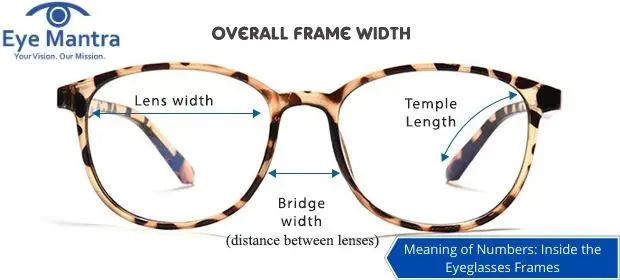
Contents
Each Eyeglasses frame is printed with various information (usually on the inside arms). This information contains the Eye size, Bridge size, Arm size, Model number, Colour code, and Brand.
The first numbers we need to look for are the three numbers that are printed on either side of a square box. These numbers are usually found on the inside of one of the arms. But in some cases, they can be printed on the back of the bridge or the inside of the nose piece.
The number on the left-hand side of the square box is the “Eye Size” and is sometimes referred to as the ‘A’ measurement. This is the width of the lens at its widest point measured in millimeters.
The number on the right-hand side of the square box is the “Bridge Size” and is sometimes referred to as the “DBL” (distance between lenses). This is the distance between the two lenses measured in millimeters (see DBL in the diagram below).
You will find a third, three-digit number, following the eye and bridge sizes, this is the ‘Arm/temple Length’. The arm length is measured in millimetres from the attachment screw to the tip of the arm. The measurement is made before the bend is put into the arm. So, if you were to physically measure your existing glasses size. You would measure from the screw to the bend and then the bend to the tip. In some cases, the arm measurement is not located alongside the eye and bridge sizes. This is usually the case when the eye and bridge sizes are printed on the back of the bridge or nose piece. However, it will generally be printed on the inside of one of the arms (look for a number between 125 and 145).
The size printed on the inside of the left temple is where the numbers are usually written. These three numbers (52-18-140 for example) are written in millimeters. These depicts: the lens diameter, the bridge width, and the length of the temple.
These measurements are not usually printed on your existing frames but, they can easily be measured with a ruler. The first measurement which is particularly useful is the “Total Width”. The total width is the overall width of the front of the frame in millimetres. The second measurement is the “Lens Depth” and is sometimes referred to as the “B” measurement. This is simply the depth of the lens measured in millimetres as per the diagram below.
Finding a frame of your choice should not be a tough task anymore. Because, now you are familiar with the numbers and eye sizes in the frame. There are two methods of choosing a frame-
In any method, you can achieve great results by comparing the eye size (A) and Bridge Size (DBL) to your existing frames. Now you can choose if you want the frame to be bigger or smaller than your existing frame, by comparing these numbers. For online purchase, most of the sites have the filter of these category pages added, by eye size and bridge size. And, if you are choosing the style of frames similar to the existing pair, this will generally work very well.
However, be mindful that the Bridge Size is not the ‘size of the bridge that fits you’. It’s the distance between the two lenses on any particular style. For example, Aviator styles, where the lenses meet very close towards the brow of the frame, have a very small bridge size with a wider eye size. Yet these can fit just as well as a more traditional style with smaller eye size and wider bridge.
The temple length can also be considered. However, in most of the cases wider frames have longer arms, so take this method as a secondary consideration.
While purchasing a new frame, compare the total width of your existing frames to those displayed, you will understand total width measurement and get better results. To measure it, place the frames on a flat surface with the arms opened. Put a ruler on top and at the front of the frame, measure the outside edge of the left arm piece to the outside edge of the right arm piece on millimetres.
When purchasing your new glasses you may choose a frame with a total Width measurement within the range of 2- 3 mm. If you are buying frame online, you can add a filter in the category page by total width and the results have shown will be within 2 millimetres of the width that you select. They will recommend the total width measurement wherever possible. When the total width is not available method 1 is preferred. For method, the temple length can be used as a secondary consideration.
The measurement of lens depth will majorly depend on the style of frame you choose to wear. And, lens depth is not required to identify a good fitting frame. However, if you are choosing glasses for Bifocals or Varifocals, keep in mind that the thinner your eyeglass frame is, the less area there will be for putting these reading element of your lens. In Varifocals lenses, the Lens Depth is at least 27 millimeters. That is why; a person should buy a frame with a lens depth less than 27 mm.
We also offer various services like Retina Surgery, Specs Removal, Lasik Surgery, Squint, Cataract Surgery, Glaucoma Surgery, and much more.